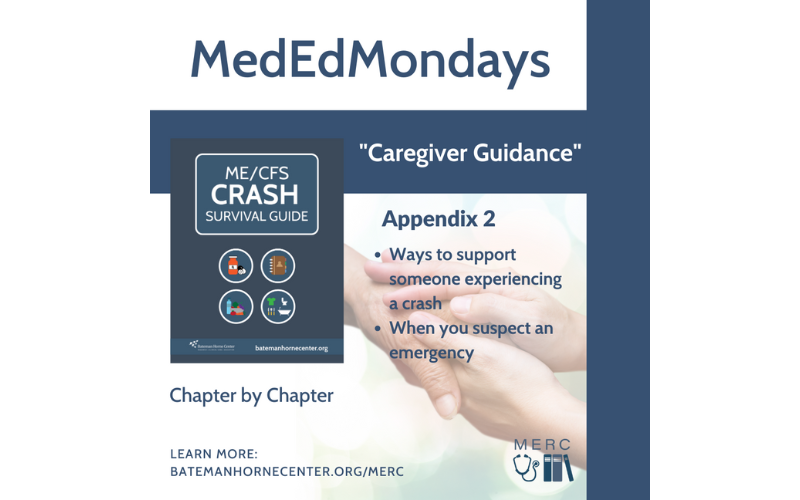This blog post covers appendix 2 of the ME/CFS Crash Survival Guide. The information provided can also apply to individuals with Long COVID and other multi-system chronic complex illnesses that have post-exertional malaise (PEM) symptoms.
Click here to download the entire guidebook.
Appendix 2: Caregiver Guidance
When someone you care about experiences a crash, it can be scary and leave you feeling helpless. This resource aims to equip you with knowledge and insights from caregiver-to-caregiver on ways to support and alleviate the suffering of the person experiencing the crash (referenced below as the patient).
1. Get the patient to a safe place
- If on the floor, provide a pillow and blanket.
- If you can get them onto the bed or couch safely, do so, otherwise keep the patient comfortable where they are.
2. Keep the patient:
- Hydrated
- Comfortable
- Horizontal
3. Contact their primary care doctor and emergency contacts to inform them of the crash.
4. Reduce or limit sensory stimuli such as light, noise, touch, smell, and other distractions to provide a quiet sensory-free environment. This includes both the direct and indirect contact the patient may have with you or their environment.
- Visual considerations: lower or eliminate all forms of light and avoid visual stimulation such as quick movements and bold or bright clothing.
- Sound considerations: reduce excessive, recurrent, overstimulating noises.
- Touch considerations: limit or soften physical touch with the crashed individual and use non-abrasive clothing and bedding.
- Smell considerations: reduce or eliminate odorous foods, plants, perfumes, body lotions, chemicals, detergents, animals, candles, etc.
- Temperature considerations: keep ambient temperature stable and utilize heating and cooling devices to assist the individual with their temperature fluctuations.
5. Recognize that the patient may not want to talk, or is unable to talk, other than to provide you with needed information.
- As a caregiver, talk only as required to aid the patient. If the patient is unable to talk, use communication cards or devices only as necessary.
6. Your #1 goal is to encourage rest, reduce movement, and help the patient conserve energy.
7. Provide light, easy to digest food as can be tolerated by the patient. It’s important to note if the patient is unable to consume food, priority should still be on adequate hydration.
8. Try to continue their medication schedule as much as possible.
9. Have the following available for the patient.
- Ice pack
- Heating pad
- Towel or washcloth
- Earplugs
- Additional bottled water or hydration packets
10. Have rescue medications available intended to decrease inflammation and muscle or joint pain, alleviate nausea and neuroinflammatory symptoms, aid with sleep and relaxation, and stabilize mast cell and hustamine activity. Work with your medical care team to find the right pharmaceutical support for you, and always consult with them prior to introducing any new over-the-counter medication or supplement.
11. When the patient is safe, calm and relaxed, take a deep breath. Know that you’re doing the best you can.
12. Seek further guidance on ways to support the individual’s progress in the ME/CFS Crash Survival Guide.
When you suspect an emergency
There may be times when the patient is in a severe state of health. If you or the individual you are caring for are concerned about the status of their condition, then it is always best to call for a professional medical assessment (whether 911 or via the emergency room or urgent care).
It is not your burden to diagnose what is wrong, so if you are questioning their safety, then you should probably seek medical evaluation.
Note: your patient may have had negative experiences in the past with emergency room visits. See the section on [https://batemanhornecenter.org/making-the-decision-to-seek-emergency-care/](Making the Decision to Seek Emergency Care) for guidance on how to prepare and support them throughout the visit.
This blog post covers the eleventh chapter of the ME/CFS Crash Survival Guide.
Click here to download the entire guidebook.
The information provided can also apply to individuals with Long COVID and other multi-system chronic complex illnesses that have post-exertional malaise (PEM) symptoms.
Bateman Horne Center relies on charitable contributions to produce
educational content such as the ME/CFS Crash Survival Guide.
Support our work by donating today!

 Lucinda Bateman, MD, is a renowned clinician, researcher, and educator. Her Johns Hopkins University Medical School training instilled an approach to care that she has employed throughout her career - the patient comes first and the unknown or unexplained does not equate to a lack of proper and compassionate care. Since starting her own practice in 2000, she has served on six boards or committees, been the principal investigator for 45 studies, authored/coauthored 40 journal articles, served as adjunct instructor and adjunct assistant professor in the University of Utah Departments of Preventative Medicine, Internal Medicine, and Anesthesiology, and lectured around the world.
Lucinda Bateman, MD, is a renowned clinician, researcher, and educator. Her Johns Hopkins University Medical School training instilled an approach to care that she has employed throughout her career - the patient comes first and the unknown or unexplained does not equate to a lack of proper and compassionate care. Since starting her own practice in 2000, she has served on six boards or committees, been the principal investigator for 45 studies, authored/coauthored 40 journal articles, served as adjunct instructor and adjunct assistant professor in the University of Utah Departments of Preventative Medicine, Internal Medicine, and Anesthesiology, and lectured around the world.